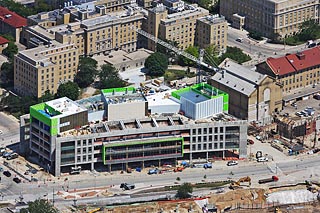Wisconsin Institutes for Discovery on track for December 2010 opening
The Wisconsin Institutes for Discovery has reached several key milestones as construction progresses on the innovative facility designed to spark collaboration among researchers and engage the public in science and learning.

An aerial view from the southwest of the construction site for the new Wisconsin Institutes of Discovery building.
Opening next December, the 300,000-square-foot building located on the UW–Madison campus between University Avenue and Campus Drive is the first research facility on campus designed to achieve LEED Silver Certification for “green” building practices. It is being built to use 50 percent less energy and water than the typical laboratory facility at UW–Madison.
“The building’s exterior curtainwall, vapor barrier and roof have been completed,” says George Austin, building project manager for the Wisconsin Alumni Research Foundation (WARF), which is funding the public/private initiative with donors John and Tashia Morgridge and the state of Wisconsin. “The building now is enclosed and completely air- and water-tight. With 46 percent of the project completed, we are excited about the high standards we are achieving for sustainable building practices. For instance, 92 percent of the project’s demolition and construction waste has been reused or recycled, surpassing our goal of 85 percent.”
Another “green” building feature is becoming visible as workers adhere more than 15,000 terra cotta tiles, each 5 feet in length and weighing 75 pounds, to the building’s exterior. A system developed in Europe, the terra cotta provides the basis for an energy-saving rain screen that uses the clay stone’s natural airtight properties to resist heat and moisture. The terra cotta also needs virtually no maintenance.
Behind the giant clay tiles, which are supported on an aluminum frame, the workers are installing mineral fiber insulation made from 90 percent recycled material and treated with silicone, and a continuous vapor barrier membrane to provide additional buffering from heat and cold. The building’s terra cotta cladding also is being constructed with overlapping, open joints that allow air to flow freely behind the tiles, resulting in a pressure-equalized system. According to Austin, “This system is engineered to reduce wind-driven rain from working its way into the wall cavity, which commonly causes wall deterioration. The open tile joints also eliminate the need for maintaining sealant or mortar joints over the life of the building.”
The terra cotta tiles and framing are manufactured by NBK in Germany and are being installed by CS&E Inc. of Germantown, Wis. As concern about rising energy costs continues to grow, this system is gaining popularity in U.S. construction. The Wisconsin Institutes for Discovery will be the second, but largest, terra cotta rain screen project completed in Wisconsin.
Other environmentally friendly features of the Wisconsin Institutes for Discovery include:
- a geothermal well system
- reduced air change rates
- daylight harvesting
- solar hot-water heating
- storm flow irrigation
- sustainable materials and building finishes
- gray water use for irrigation
- atria thermodynamics
- high-efficiency lighting, water flow fixtures and HVAC systems
- a commitment to serving locally grown foods
The facility, designed by Ballinger and Uihlein Wilson Architects and constructed by Findorff|Mortenson (a joint venture), will house twin interdisciplinary biomedical research institutes under one roof: the private, nonprofit Morgridge Institute for Research and the university’s public Wisconsin Institute for Discovery. In addition, a “town center” filling the main floor will welcome all with food, displays, events, learning labs and meeting spaces.
Building residents, visitors to the town center and even remote observers will be able to view real-time energy usage and performance metrics for the building via their computers, public monitors and the institutes’ Web site.
More information about the Wisconsin Institutes for Discovery, including a video focusing on the facility’s green construction and features, is available at http://www.discovery.wisc.edu.



